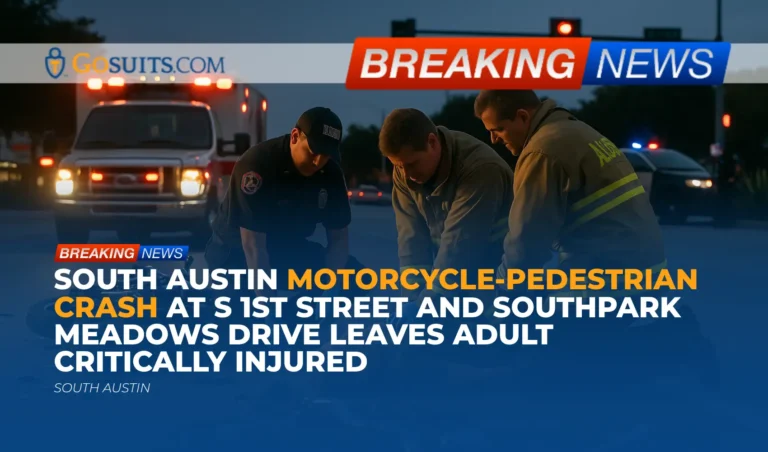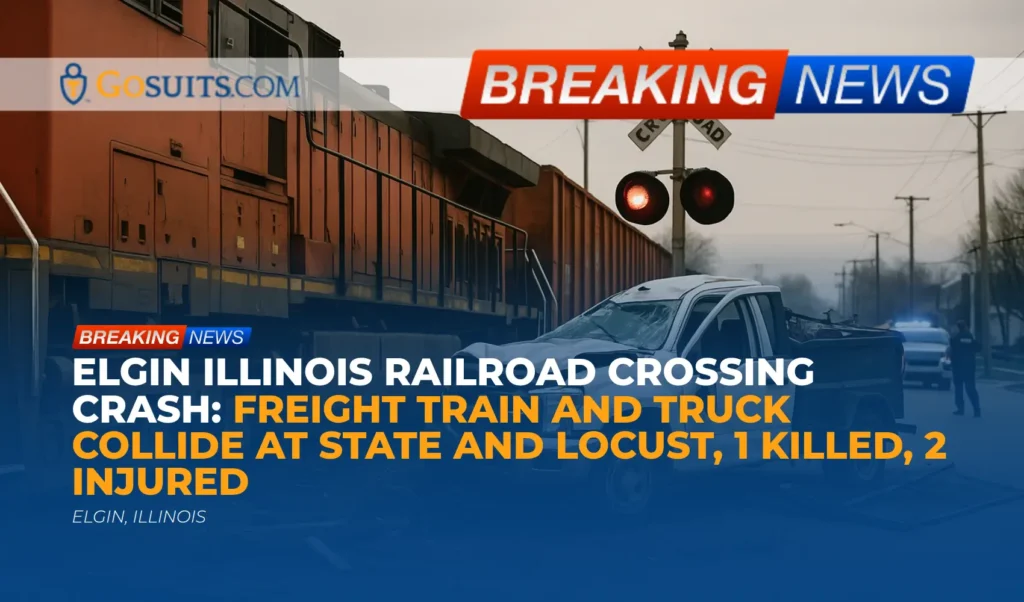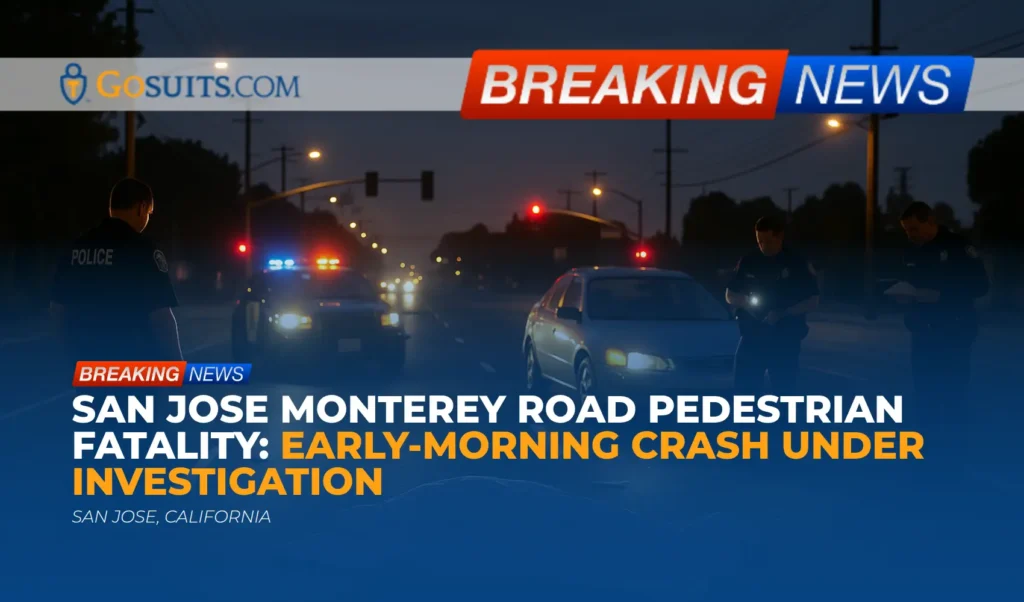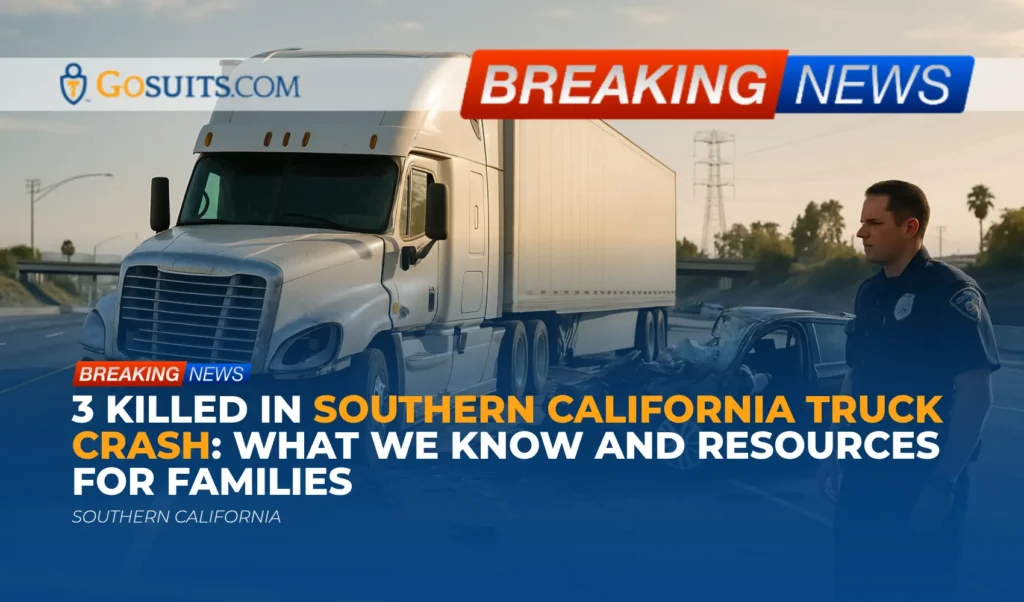Safety and legal context in Texas
Potential civil liability considerations
Evidence to preserve and why it matters
Where to obtain official records and information
Insurance and claims overview in Texas
Common injuries in motorcycle pedestrian collisions
Community safety and the intersection environment
What to do after a serious injury or loss
Important time limits in Texas
Commentary from Gosuits Austin, Texas Personal Injury Attorney
Why taking prompt, informed action matters now
Incident summary
In South Austin, a collision involving a motorcycle and a pedestrian occurred near the intersection of S 1st Street and Southpark Meadows Drive on Sunday evening at approximately 7:30 p.m. Austin Travis County EMS reported that one adult patient was in critical condition, with CPR in progress on scene. The individual was transported to St. David’s South Austin Hospital around 7:45 p.m. No additional official details were available at the time of this writing. Our thoughts are with all those affected by this sudden and traumatic event.
What is known so far
Based on the initial information provided by local emergency responders:
- Location: S 1st Street at Southpark Meadows Drive in South Austin.
- Time: Reported around 7:30 p.m. on a Sunday evening.
- Parties involved: A motorcycle and an adult pedestrian.
- Injuries: One adult sustained critical injuries and required CPR.
- Transport: The injured person was transported to a nearby hospital around 7:45 p.m.
- Status of investigation: No further information has been released at this time.
When information is limited, it is normal for families and community members to have questions about what happened and what steps come next. The sections below offer general safety, legal, and practical guidance relevant to incidents like this one in Austin and throughout Texas.
Safety and legal context in Texas
Pedestrian rights and duties at and near crosswalks
Texas law outlines the responsibilities of both drivers and pedestrians in shared spaces. At crosswalks where traffic signals are not present, drivers must yield the right of way to a pedestrian in a crosswalk on the half of the roadway the vehicle is traveling or approaching so closely as to be in danger. See Texas Transportation Code Section 552.003.
Drivers must also exercise due care to avoid colliding with a pedestrian on any roadway and must take proper precautions when seeing a child or a person who is confused or incapacitated. See Section 552.008.
Pedestrians are required to yield to vehicles when crossing outside a crosswalk in many settings, and they generally should not suddenly leave a curb and move into the path of a vehicle that is so close that it is impossible for the vehicle to yield. See Section 552.005.
These rules are designed to reduce conflicts, but they do not change the reality that pedestrians are extremely vulnerable even in low speed impacts. Evening hours can add risk due to visibility, traffic volume, and potential glare.
Motorcyclists and intersection safety
Motorcycles have a smaller profile and may be less visible to others, especially in complex intersections and at dusk or night. While motorcyclists must follow the same traffic laws as other vehicles, everyone approaching intersections has a duty to use care, maintain a safe speed for conditions, and keep a proper lookout. The general duty for drivers to exercise care toward pedestrians applies regardless of vehicle type under Section 552.008.
Shared responsibility in Texas civil cases
In Texas, if a civil claim is later brought, a jury may consider whether each party contributed to an incident. This is called proportionate responsibility. Under the Texas Civil Practice and Remedies Code Chapter 33, a claimant’s recovery can be reduced by their percentage of responsibility, and there are limits if a claimant is found to be more than 50 percent responsible. Every collision is fact specific, and early evidence preservation is essential to understanding what truly occurred.
Potential civil liability considerations
It is too early to determine fault in this Austin crash without official findings. Generally, investigators will look at:
- Right of way and signal phase: Whether a pedestrian was within a crosswalk and whether signals or signage were present and obeyed.
- Speed and lookout: Whether vehicle speed was reasonable for lighting and traffic conditions and whether the operator maintained a proper lookout.
- Lighting and visibility: Street lighting, ambient light, glare from oncoming traffic, and clothing visibility can influence perception response time.
- Roadway design and obstructions: Placement of crosswalks, stop bars, sightlines, and any temporary obstructions.
- Mechanical factors: Braking capability, tire condition, lights, or other mechanical issues.
Depending on the facts, responsible parties could include a vehicle operator, potentially another road user, or in limited circumstances an entity responsible for roadway design or maintenance. Claims against a governmental entity involve special notice and immunity rules, discussed below.
Evidence to preserve and why it matters
Understanding how a collision occurred depends on timely gathering of evidence. Many key items are time sensitive and may be lost quickly if not secured:
- Scene photographs and measurements: Skid marks, debris fields, vehicle rest positions, and lighting conditions can fade or be altered within hours.
- Surveillance and dash cameras: Nearby businesses and transit stops sometimes record roadway footage, but many systems overwrite within days.
- 911 audio and dispatch data: Call recordings, CAD logs, and unit arrival times can support timelines.
- Body worn camera and in car video: Police videos may capture the scene condition and early witness statements.
- EMS run sheets and hospital records: Document injury severity, initial observations, and timelines of care.
- Vehicle inspection and data: Post crash inspection of a motorcycle and any involved vehicles can reveal damage consistency, light filament status, and mechanical conditions. Some devices and apps may contain speed or location data.
- Witness identities and statements: Independent witnesses can clarify signal phases, speeds, and movements.
Because what is said to insurers can be recorded and used later, speaking with a seasoned personal injury attorney before giving any statements can help protect legal options and ensure that evidence is preserved appropriately.
Where to obtain official records and information
Police crash reports for Austin incidents
For reportable crashes investigated by police in Texas, the official crash report (CR 3) is generally available through the Texas Department of Transportation’s online system. Reports can be purchased at the Crash Records Information System portal: TxDOT CRIS. The City of Austin also processes open records requests through its Public Records Center: Austin Public Records Center, where requesters can ask for supplemental materials such as photos, body worn camera video, or 911 audio, subject to legal exemptions and redactions.

Austin Travis County EMS records
EMS incident reports and certain dispatch records can often be requested from Austin Travis County EMS through the City’s public records portal. The department’s information page is here: Austin Travis County EMS. To submit an official request, use the City’s portal: Austin Public Records Center.
Medical examiner and autopsy information for Travis County
In collisions that result in a fatality, the Travis County Medical Examiner’s Office conducts medicolegal death investigations. Information for families about reports and processes is available at the county’s official page: Travis County Medical Examiner. Texas death certificates are issued through the Department of State Health Services Vital Statistics unit: Texas DSHS Vital Statistics. Release of autopsy and investigative reports follows state public information laws and may be limited to next of kin or released with redactions where required by law.
Hospital medical records
Patients and authorized representatives generally have a right to access medical records under federal privacy rules. The U.S. Department of Health and Human Services provides guidance on the HIPAA right of access here: HHS HIPAA Right of Access. Hospitals have their own processes and timelines for fulfilling record requests; identification and proper authorization are typically required.
City safety programs and crash data
For broader context on traffic safety efforts in Austin, the City’s Vision Zero program shares strategy and data on reducing serious injuries and fatalities on city streets: City of Austin Vision Zero. This information can help residents understand ongoing safety improvements near high activity corridors such as S 1st Street.
Insurance and claims overview in Texas
Texas requires drivers to carry liability insurance with minimum limits, commonly referred to as 30/60/25. The Texas Department of Insurance explains these requirements and coverage types here: TDI Auto Insurance Guide. Liability coverage can apply when a driver or motorcyclist is legally responsible for injury to others. Optional coverages, such as personal injury protection and uninsured or underinsured motorist coverage, may also be involved depending on the policies in place.
In any potential claim, statements given to insurance adjusters can affect outcomes. It is prudent to speak with a skilled personal injury attorney before providing recorded statements or signing documents. An attorney can explain rights, coordinate communications, and help ensure that critical evidence is preserved. What is shared with insurers can be used later, and once recorded, statements are difficult to retract.
Common injuries in motorcycle pedestrian collisions
Pedestrian impacts can cause life altering trauma even at modest speeds. The Centers for Disease Control and Prevention provides information about traumatic brain injuries, which are a common result of blunt force impacts: CDC Traumatic Brain Injury. Fractures, internal injuries, and severe soft tissue damage are also common. Rapid EMS response and advanced trauma care significantly influence outcomes.
National safety agencies emphasize that pedestrians and motorcyclists are both vulnerable road users. The National Highway Traffic Safety Administration provides safety context and prevention strategies for pedestrian crashes here: NHTSA Pedestrian Safety. While each incident is unique, data consistently show higher risks during low light conditions and at multi lane or high speed corridors.
Community safety and the intersection environment
The area around S 1st Street and Southpark Meadows Drive serves both through traffic and access to commercial areas. In such environments, several factors can increase risk:
- Multiple conflict points: Driveways, turn lanes, and signal phases create more decision points for every user.
- Lighting and contrast: Evening conditions reduce contrast, making pedestrians harder to detect. Dark clothing compounds this issue.
- Speed variability: Differences between posted speed and actual operating speed can reduce stopping distance and increase injury severity.
- Distraction and workload: Visual clutter, signage, and in vehicle distractions make attention management critical.
City programs like Vision Zero evaluate corridors and intersections for countermeasures that can reduce risk, including improved lighting, high visibility crosswalks, leading pedestrian intervals, and traffic calming. Community input and crash reporting help guide where changes can have the most impact. See City of Austin Vision Zero for more on these efforts.
What to do after a serious injury or loss
After a serious collision, the immediate focus is medical care and safety. As the situation stabilizes, careful steps can help protect legal rights and reduce future stress:
- Prioritize medical treatment and follow up: Continue care as advised by medical professionals. Keep copies of discharge summaries, imaging reports, referrals, and bills.
- Preserve evidence early: Save clothing, damaged items, and photos. Note any nearby cameras and request that footage be preserved.
- Request official records: Obtain the police crash report via TxDOT CRIS and make an open records request through the Austin Public Records Center for supplemental materials such as 911 audio or video, where available.
- Document lost wages and out of pocket expenses: Keep pay stubs and employer letters regarding missed work, and save receipts for medical and transportation costs.
- Avoid posting about the collision on social media: Public posts can be misinterpreted and may be used by insurers to challenge claims.
- Consult an attorney before speaking with insurers: Insurance adjusters may request recorded statements early. Because statements can be used later, consider obtaining a free consultation with a personal injury attorney first to understand rights and risks.

Important time limits in Texas
Texas law generally allows two years from the date of injury to bring most personal injury claims, and the same period often applies to wrongful death and survival actions. See Texas Civil Practice and Remedies Code Section 16.003. There are exceptions that can shorten or extend deadlines in specific circumstances.
If a governmental entity may be implicated by roadway conditions, signage, or other factors, additional rules apply. The Texas Tort Claims Act requires notice of a claim within six months of the incident in most cases, describing the damage or injury, the time and place, and the incident. See Section 101.101. Some local governments have shorter notice periods by charter or ordinance. Meeting these deadlines requires early evaluation.
Because deadlines are critical and fact dependent, prompt action to understand which time limits apply is important.
Commentary from Gosuits Austin, Texas Personal Injury Attorney
Our hearts are with the person who was critically injured and with the loved ones and witnesses affected by this South Austin crash. Collisions like this are sudden, frightening, and disorienting. This commentary is provided for educational purposes and general information to help the community understand the safety and legal context that may surround an event like this.
Intersections that serve both through traffic and busy commercial destinations create complex conditions for everyone on the road. In our view, any investigation should carefully examine visibility, lighting, speed relative to conditions, crosswalk placement, and whether all users followed the rules that exist to protect pedestrians. Texas law imposes a duty on drivers to exercise due care to avoid colliding with pedestrians, and that standard applies to motorcyclists as well. At the same time, real world conditions at dusk can change reaction times and increase risk. Understanding what actually happened depends on careful, early evidence collection.
Insurance companies and large corporations often move quickly after a serious crash to obtain statements and records. Adjusters sometimes ask leading questions, press for quick recorded statements, or offer early payments before the full scope of injuries is known. These tactics can take advantage of a person’s lack of familiarity with the claims process and the stress that follows a traumatic event. Signing broad medical authorizations or giving recorded statements without context can limit options later.
Free consultations with a personal injury attorney allow people to understand potential rights and risks at no cost. An attorney can help coordinate evidence preservation, communicate with insurers, and outline timelines without making promises about outcomes. Getting informed early can prevent missteps and protect a person’s ability to make decisions based on the full picture.
Why taking prompt, informed action matters now
- Secure time sensitive evidence: Surveillance video often overwrites within days, physical marks fade, and witnesses become harder to locate. Acting promptly increases the chance of obtaining critical footage, 911 audio, and scene measurements.
- Meet legal deadlines: Texas has strict statutes of limitations for injury and wrongful death, and potential notice requirements for claims involving public entities. Early action preserves options and reduces the risk of missing a deadline.
- Avoid harmful statements: Insurers may request recorded statements quickly. Speaking without context can unintentionally shift responsibility or limit compensation for future care. Consulting with counsel first helps ensure communications are accurate and appropriately limited.
- Document medical care and costs: Organized records of treatment, diagnoses, and out of pocket expenses support a clear picture of harm and needs. Starting early prevents gaps and lost documentation.
- Evaluate all insurance coverages: Identifying every applicable policy, including liability, uninsured or underinsured motorist, and personal injury protection, can change the resources available for recovery. Policies and exclusions are complex and benefit from careful review.
- Protect long term wellbeing: Early guidance can help arrange necessary follow up care, preserve income documentation, and reduce the burden on families already coping with trauma.
In situations like this, practical steps that focus on safety, documentation, and informed decision making offer the best path toward clarity and stability in the weeks and months ahead.






